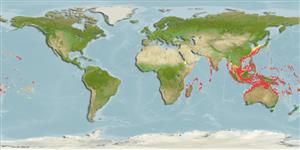Common names from other countries
分類 / Names
共通名の | 類義語 | Catalog of Fishes(部類, 種) | ITIS | CoL | WoRMS | Cloffa
>
Eupercaria/misc (Various families in series Eupercaria) >
Lethrinidae (Emperors or scavengers) > Lethrininae
Etymology: Lethrinus: Greek, lethrinia, a fish pertaining to genus Pagellus.
Environment: milieu / climate zone / depth range / distribution range
生態学
海 関連する礁; 移住性ではない; 深さの範囲 10 - 198 m (Ref. 86942). Tropical; 38°N - 31°S, 30°E - 139°W
Indo-Pacific: East Africa to south Korea in the Yellow Sea, and the Marquesas Islands.
Length at first maturity / サイズ / 重さ / 年齢
Maturity: Lm 23.0, range 20 - 26 cm
Max length : 57.0 cm FL オス/雌雄の選別がない; (Ref. 125599); common length : 30.0 cm TL オス/雌雄の選別がない; (Ref. 2295); 最大公表体重: 3.1 kg (Ref. 125599)
背面の脊椎 (合計) : 10; 背鰭 (合計) : 9; 肛門の骨: 3; 臀鰭: 8. This species is distinguished by the following characters: body moderately elongate, its depth 3-3.4 times in standard length; head length 1.1-1.3 times in body depth, 2.6-3 times in SL, dorsal profile near eye convex without a distinct hump; snout length 1.8-2.1 times in HL, measured without the lip the snout is 0.7-0.9 times in cheek height, its dorsal profile nearly straight or slightly concave, snout angle relative to upper jaw between 54° and 65°; interorbital space flat or slightly convex; posterior nostril a longitudinal oblong opening, closer to orbit than anterior nostril; eye situated close or slightly removed from dorsal profile, its length 3.9-4.7 times in HL; cheek height 2.4-3.3 times in HL; lateral teeth in jaws conical; outer surface of maxilla smooth or with a longitudinal ridge; D X,9 with the 3rd dorsal-fin spine the longest, its length 2.4-2.7 times in body depth; A III,8 with the first soft ray usually the longest, its length shorter than length of base of soft-rayed portion of anal fin and 1.4-1.8 times in length of entire anal-fin base; pectoral-fin rays 13; pelvic-fin membranes between rays closest to body without dense melanophores; cheek without scales; 47-49 lateral-line scales; 4 ½ scale rows between lateral line and base of middle dorsal-fin spines; 15-16 scale rows in transverse series between origin of anal fin and lateral line; usually 15 rows in lower series of scales around caudal peduncle; 7-10 scales in supratemporal patch; inner surface of pectoral-fin base without scales; posterior angle of operculum with a wide scaleless area. Colour of body olive grey or brown, with scattered irregular small black blotches; lips and a spot on upper edge of operculum usually red; fins pale or pinkish (Ref. 114226).
Found over sand and rubble areas of outer reef slopes (Ref. 30573). Feeds mainly on crustaceans, fish, echinoderms and mollusks (Ref. 30573). In New Caledonia, spawning peaks are observed in December and a fairly high percentage of gonads in advanced stages of maturity occurs between October and February (Ref. 9775). Caught mostly by handline, trap, and trawl. Marketed mostly fresh. An excellent food fish (Ref. 114226).
Life cycle and mating behavior
Maturities | 繁殖 | Spawnings | Egg(s) | Fecundities | 幼生
Oviparous (Ref. 205). Also Ref. 103751.
Carpenter, K.E. and G.R. Allen, 1989. FAO Species Catalogue. Vol. 9. Emperor fishes and large-eye breams of the world (family Lethrinidae). An annotated and illustrated catalogue of lethrinid species known to date. FAO Fish. Synop. 125(9):118 p. Rome: FAO. (Ref. 2295)
CITES (Ref. 128078)
Not Evaluated
Human uses
水産業: 高い商業の
用具
特記事項
XMLをダウンロードして下さい
インターネットの情報源
Estimates based on models
Preferred temperature (Ref.
115969): 22.4 - 28.3, mean 26.9 (based on 844 cells).
Phylogenetic diversity index (Ref.
82804): PD
50 = 0.5000 [Uniqueness, from 0.5 = low to 2.0 = high].
Bayesian length-weight: a=0.01445 (0.01230 - 0.01698), b=2.97 (2.93 - 3.01), in cm Total Length, based on LWR estimates for this species (Ref.
93245).
栄養段階 (Ref.
69278): 3.8 ±0.0 se; based on diet studies.
回復力 (Ref.
120179): 手段, 1.4年~4.4年の倍増期間の最小個体群 (Preliminary K or Fecundity.).
Fishing Vulnerability (Ref.
59153): Low to moderate vulnerability (33 of 100).
